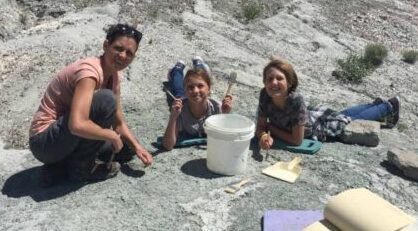Typically the first question someone interested in paleontology asks themselves is “what type of fossils do I want to work with?”
First, let’s answer the question “what is a fossil?” A fossil is evidence of a previously living organism preserved as a geologic object. These range from bones turning into stone, to impressions of leaves being preserved in mud, to the sediment mold of a shell, and much more.
Fossils come in many forms which we have classified into helpful categories. Starting with the most broad umbrella terms for fossil types, we have body fossils, ichnofossils (trace fossils), and molecular fossils. Body fossils have a straightforward definition, these fossils were once physically part of an organism. Some examples are teeth, bones, shells, petrified wood, and sometimes soft tissues like muscle and feathers. Ichnofossils, also known as trace fossils, are preserved evidence of an organism interacting with its environment. Trace fossils come in many forms like body fossils, with some examples including eggshells, dung, footprints, burrows, and worm trails. Molecular fossils, which are often called biomarkers, are a bit more complicated. These are chemical signatures produced, typically by microorganisms, that are incorporated into sediments and sedimentary rocks.
From there, we can get more specific. For instance, paleontologists studying body fossils can be classified based on what type of organism they wish to study. Paleontologists who study animal fossils are typically divided into vertebrate paleontologists and invertebrate paleontologists, depending on if they want to work with animals with a bony skeleton or animals without a bony skeleton. Paleontologists who study plant fossils are called paleobotanists and if they focus on pollen fossils specifically they are palynologists. Paleontologists interested in studying fossil fungi are called paleomyconologists. And last but certainly not least are the micropaleontologists, those who work with microscopic fossils. These can belong to bacteria, archaeans, as well as microscopic remains of animals, plants, and fungi.
With such a broad field, everyone can find something they are truly passionate about. Some people love all dinosaurs equally, some people prefer specific dinosaurs, and some still prefer trilobites over all dinosaurs. There is no wrong choice regarding what fossils to love and study. What’s important is for paleontologists to work with what they love and to work well with other paleontologists, whether they have similar interests or vastly different ones.
Tag: Outdoor adventure
The Excitement of a Montana Dinosaur Dig
Are you a fan of dinosaurs? If so, you won’t want to miss the opportunity to participate in a Montana dinosaur dig! Montana is a prime location for fossil hunting, and offers a unique and exciting experience for anyone interested in paleontology.
One of the best things about a Montana dinosaur dig is that it allows you to get hands-on experience with the fossils. You’ll have the opportunity to excavate real dinosaur bones, and may even make a significant discovery. This is a great way to learn about the prehistoric world and gain a deeper understanding of the dinosaurs that once roamed the earth.
In addition to the hands-on experience, a Montana dinosaur dig also offers the chance to explore the beautiful outdoors. Montana is home to stunning natural scenery, and a fossil dig allows you to take in the sights and sounds of the natural world. You’ll have the opportunity to hike through the rugged terrain, and may even spot some of the state’s abundant wildlife.
Another great reason to visit Montana for a dinosaur dig is the expert guidance you’ll receive. The fossil dig expeditions are led by knowledgeable guides who can provide you with valuable information and insights about the fossils and the surrounding environment. You’ll have the chance to learn from the experts and expand your knowledge of paleontology.
So why not plan a trip to Montana and participate in a dinosaur dig? It’s a once-in-a-lifetime opportunity to get up close and personal with prehistoric fossils, and explore the beautiful outdoors of Montana. Don’t miss out on this unique experience – book your Montana dinosaur dig today!
